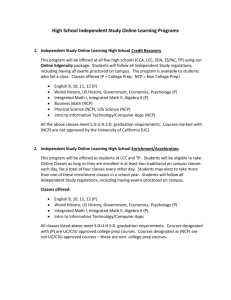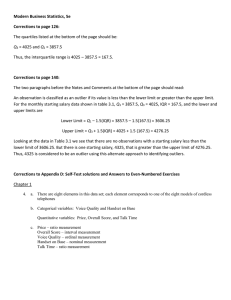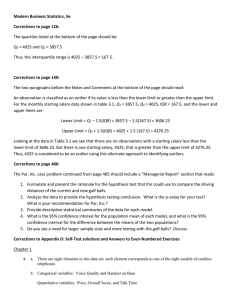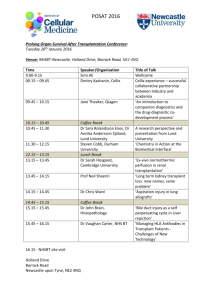Stat 516 Homework 5 Solutions
advertisement
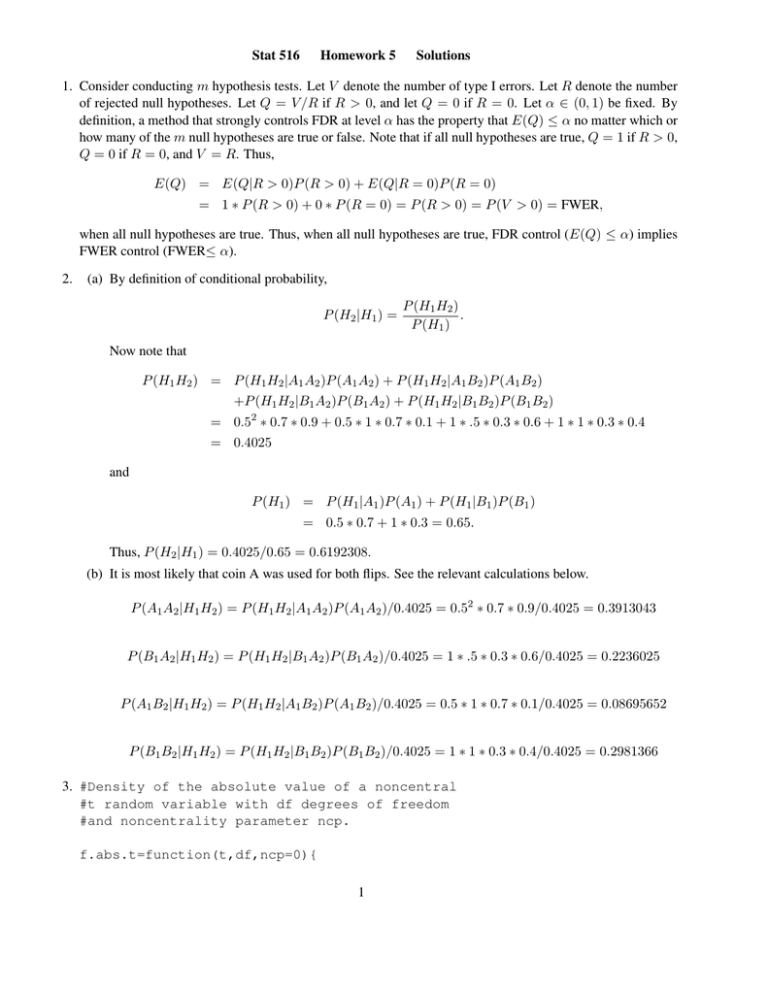
Stat 516
Homework 5
Solutions
1. Consider conducting m hypothesis tests. Let V denote the number of type I errors. Let R denote the number
of rejected null hypotheses. Let Q = V /R if R > 0, and let Q = 0 if R = 0. Let α ∈ (0, 1) be fixed. By
definition, a method that strongly controls FDR at level α has the property that E(Q) ≤ α no matter which or
how many of the m null hypotheses are true or false. Note that if all null hypotheses are true, Q = 1 if R > 0,
Q = 0 if R = 0, and V = R. Thus,
E(Q) = E(Q|R > 0)P (R > 0) + E(Q|R = 0)P (R = 0)
= 1 ∗ P (R > 0) + 0 ∗ P (R = 0) = P (R > 0) = P (V > 0) = FWER,
when all null hypotheses are true. Thus, when all null hypotheses are true, FDR control (E(Q) ≤ α) implies
FWER control (FWER≤ α).
2.
(a) By definition of conditional probability,
P (H2 |H1 ) =
P (H1 H2 )
.
P (H1 )
Now note that
P (H1 H2 ) = P (H1 H2 |A1 A2 )P (A1 A2 ) + P (H1 H2 |A1 B2 )P (A1 B2 )
+P (H1 H2 |B1 A2 )P (B1 A2 ) + P (H1 H2 |B1 B2 )P (B1 B2 )
= 0.52 ∗ 0.7 ∗ 0.9 + 0.5 ∗ 1 ∗ 0.7 ∗ 0.1 + 1 ∗ .5 ∗ 0.3 ∗ 0.6 + 1 ∗ 1 ∗ 0.3 ∗ 0.4
= 0.4025
and
P (H1 ) = P (H1 |A1 )P (A1 ) + P (H1 |B1 )P (B1 )
= 0.5 ∗ 0.7 + 1 ∗ 0.3 = 0.65.
Thus, P (H2 |H1 ) = 0.4025/0.65 = 0.6192308.
(b) It is most likely that coin A was used for both flips. See the relevant calculations below.
P (A1 A2 |H1 H2 ) = P (H1 H2 |A1 A2 )P (A1 A2 )/0.4025 = 0.52 ∗ 0.7 ∗ 0.9/0.4025 = 0.3913043
P (B1 A2 |H1 H2 ) = P (H1 H2 |B1 A2 )P (B1 A2 )/0.4025 = 1 ∗ .5 ∗ 0.3 ∗ 0.6/0.4025 = 0.2236025
P (A1 B2 |H1 H2 ) = P (H1 H2 |A1 B2 )P (A1 B2 )/0.4025 = 0.5 ∗ 1 ∗ 0.7 ∗ 0.1/0.4025 = 0.08695652
P (B1 B2 |H1 H2 ) = P (H1 H2 |B1 B2 )P (B1 B2 )/0.4025 = 1 ∗ 1 ∗ 0.3 ∗ 0.4/0.4025 = 0.2981366
3. #Density of the absolute value of a noncentral
#t random variable with df degrees of freedom
#and noncentrality parameter ncp.
f.abs.t=function(t,df,ncp=0){
1
(t>0)*(dt(t,df=df,ncp=ncp)+dt(-t,df=df,ncp=ncp))
}
#Density of the p-value from a t-test
#when the noncentrality parameter is ncp
#and the degrees of freedom are df.
f=function(p,df,ncp=0)
{
tt=qt(1-p/2,df=df)
f.abs.t(tt,df=df,ncp=ncp)/f.abs.t(tt,df=df)
}
f(.1,18,1.6)
[1] 2.072947
4.
(a) NR = 2.12 + 2.23 + 4.42 + 2.14 = 10.91 N − NH = 10 − 4 = 6
i Ordered Stat Phit (S, i) Pmiss (S, i) Phit (S, i) − Pmiss (S, i)
1
-4.42
4.42/10.91
0
4.42/10.91
2
-2.14
6.56/10.91
0
6.56/10.91
3
-2.12
8.68/10.91
0
8.68/10.91
4
-0.25
8.68/10.91
1/6
8.68/10.91-1/6
5
-0.17
8.68/10.91
1/3
8.68/10.91-1/3
6
-0.14
8.68/10.91
1/2
8.68/10.91-1/2
7
0.26
8.68/10.91
2/3
8.68/10.91-2/3
8
0.36
8.68/10.91
5/6
8.68/10.91-5/6
9
0.60
8.68/10.91
1
8.68/10.91-1
10
2.23
1
1
0
[1,]
[2,]
[3,]
[4,]
[5,]
[6,]
[7,]
[8,]
[9,]
[10,]
Phit
0.4051329
0.6012832
0.7956004
0.7956004
0.7956004
0.7956004
0.7956004
0.7956004
0.7956004
1.0000000
Pmiss Phit-Pmiss
0.0000000 0.40513291
0.0000000 0.60128323
0.0000000 0.79560037
0.1666667 0.62893370
0.3333333 0.46226703
0.5000000 0.29560037
0.6666667 0.12893370
0.8333333 -0.03773297
1.0000000 -0.20439963
1.0000000 0.00000000
(b) M (S) = 0.7956, m(S) = −0.2044
(c) ES(S) = 0.7956
(d) getES=function(r,S,p=1,plt=F)
{
N=length(r)
NH=length(S)
inS=(1:N)%in%S
2
Pmiss=(!inS)/(N-NH)
Phit=inS*abs(r)ˆp/sum(abs(r[inS])ˆp)
ordr=order(r)
Pmiss=cumsum(Pmiss[ordr])
Phit=cumsum(Phit[ordr])
Phit.Pmiss=Phit-Pmiss
mM=range(Phit.Pmiss)
Mgenm=(mM[2]>=-mM[1])
ES=mM[2]*Mgenm+mM[1]*(1-Mgenm)
if(plt){
plot(1:N,Phit.Pmiss)
lines(1:N,Phit.Pmiss)
}
ES
}
(e)
n=10000
es=rep(0,n)
for(i in 1:n){
es[i]=getES(rnorm(1000),1:100)
}
hist(es)
3
1500
1000
0
500
Frequency
2000
Histogram of es
−0.4
−0.2
0.0
0.2
0.4
es
(f) No simulation is actually necessary here. It is not difficult to see that M (S) and m(S) are guaranteed to
be 0.5 and -0.5, respectively.
(g) Yes. An enrichment score of 0.5 or -0.5 is more extreme (farther from 0) than the statistics in part (e).
4
